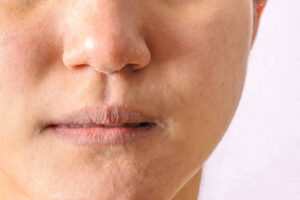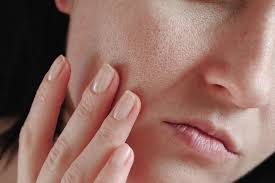[vc_row][vc_column][vc_column_text]
What Is Smooth Skin?
Skin that is smooth and glowing skin is said to be healthy. Dryness, hyperpigmentation, acne, fine lines, and wrinkles are all signs that your skin is unhealthy. The rough and uneven texture of these skin problems is the result of these disorders. You must eliminate the causes of rough skin texture to achieve smooth skin.[/vc_column_text][/vc_column][/vc_row][vc_row][vc_column][vc_column_text]
What Causes Rough Skin?
These are the main causes behind rough skin:
- Free radicals and reactive oxygen species (ROS) are produced by UV radiation and pollution, which increase photodamage and cause premature skin ageing. Fine lines, wrinkles, decreased skin smoothness, and developing hyperpigmentation are the outcomes

- Insufficient hydration, as well as underlying skin diseases like eczema and psoriasis, can make your skin feel dry and rough.
- Skin diseases including generalised xerosis and follicular hyperkeratosis can be caused by a lack of vitamin A. Fine wrinkles and scales on the skin are signs of xerosis, which is caused by a vitamin A deficiency. Red-brown follicular papules with a central keratotic spinous plug are the hallmarks of follicular hyperkeratosis.
[/vc_column_text][/vc_column][/vc_row][vc_row][vc_column][vc_column_text]
How can I improve my skin texture?
You can refocus your skincare routine and lifestyle behaviours to get smoother skin by understanding the reasons that create rough skin.
1: consistent cleansing routine.
Your skin type and other skin conditions will determine which cleanser is best for you. If you have dry or sensitive skin, for example, you might prefer a moisturising cream or an oil cleanser. If you have oily skin, a gel or foamy cleanser may be preferable.
2: Exfoliate with glycolic acid
You can use exfoliating solutions to remove any remaining debris, dead skin cells, or oil from your skin. There are a few various approaches you can take. Physical exfoliants, such as scrubs or brushes, are used to physically remove contaminants. Chemical exfoliants, on the other hand, are chemicals that dissolve the connections between skin cells, allowing them to be simply removed. Chemical exfoliation, according to dermatologists, is “usually more reliable and less severe than mechanical exfoliants like scrubs and polishes.” Alpha hydroxy acids (AHAs), such as glycolic and lactic acid, and beta hydroxy acids (BHAs), such as salicylic acid, are examples of chemical exfoliants. Some chemical exfoliant products, such as serums, toners, and masks, contain both AHAs and BHAs.
[/vc_column_text][/vc_column][/vc_row][vc_row][vc_column][vc_column_text]3: Try using topical retinoids to increase skin cell turnover
Your skin cells are structured in layers, with the youngest at the bottom and the oldest at the top. When you exfoliate, you’re eliminating the top layer of skin cells to reveal the younger, smoother, and frequently glistening skin beneath.
eliminating the top layer of skin cells to reveal the younger, smoother, and frequently glistening skin beneath.
Retinoids, on the other hand, include over-the-counter retinol and adapalene (Differin), as well as prescription tretinoin (Retin-A). These are all vitamin A derivatives, which the skin requires to operate correctly.
4: Soften skin with lactic acid
If your tough skin is also dry, a little lactic acid can help soften it up. If you’re naturally dry, this moderate exfoliating acid is the most hydrating of the alpha hydroxy acid (AHA) family of chemical exfoliators, so you can moisturise while sloughing the dead skin away. For an even milder approach, use moisturising moisturisers that contain lactic acid.[/vc_column_text][/vc_column][/vc_row][vc_row][vc_column][vc_column_text]5: Always use sunscreen during the day
Everyone uses sunscreen every day to protect their skin and promote a more even tone and texture in the long run.
Look for a sunscreen (or a moisturiser with SPF) with at least 30 SPF and broad spectrum protection, which means it shields you from both UVA and UVB radiation. If you have oily or acne-prone skin, look for a facial moisturizer product that won’t clog your pores. The most important thing, though, is to choose one that you enjoy enough to wear every day.
6: Prioritize getting good sleep to help your skin heal
We know that stress has an impact on the skin, and we also know that the skin heals quickly. Make getting a good night’s sleep a priority since it gives the body the time it needs to repair damaged skin cells.[/vc_column_text][/vc_column][/vc_row][vc_row][vc_column][vc_column_text]7: Talk to a dermatologist for more help
Since there are so many factors that can create rough or bumpy skin, it’s best to consult a dermatologist if you’re not sure what’s causing your problems. Also, if your skin is inflamed and becomes itchy or very red, it’s time to consult a specialist. These are indicators that your bumpy, rough skin is caused by a condition such as eczema or keratosis pilaris, which should be treated by a dermatologist.
what’s causing your problems. Also, if your skin is inflamed and becomes itchy or very red, it’s time to consult a specialist. These are indicators that your bumpy, rough skin is caused by a condition such as eczema or keratosis pilaris, which should be treated by a dermatologist.
8. Eating foods high in antioxidants
Foods high in antioxidants have a beneficial effect on the skin. Leafy greens, yellow and orange fruits and vegetables, and fatty seafood like salmon are among these foods. There’s also evidence that including probiotics in your diet can help cure and prevent skin diseases like eczema and acne, as well as skin damage caused by UV rays.[/vc_column_text][/vc_column][/vc_row][vc_row][vc_column][vc_column_text]9: Exercising
Studies on both animals and people Regular aerobic activity can improve the nature of the skin. It smooths the outer layer of the skin while growing the inner layers, which is the polar opposite of what occurs as we age. Smoother, younger-looking skin is the consequence of this process.
10: Drinking less alcohol
Skin photodamage, or damage induced by sunshine, has been linked to alcohol consumption. Dehydration, which promotes dry skin and premature ageing, can also be caused by drinking too much. Limit your alcohol consumption to one or two drinks each day to reduce the negative effects of alcohol on your body and skin.[/vc_column_text][/vc_column][/vc_row][vc_row][vc_column][vc_column_text]
Best Smoothing Skincare Ingredients
Exfoliating, hydrating, and protecting are all roles that skin smoothing chemicals should have. With that in mind, here are some of the top skin-smoothing ingredients:
AHAs and BHAs
Acids like salicylic and glycolic acid can help keep your skin clean and remove dead skin cells, allowing for a skin renewal process and revealing a glowing complexion beneath.
Snail Mucin Extract
Snail mucus is a potent skin smoothing ingredient that increases collagen formation and minimises wrinkles and fine lines by being naturally rich in allantoin, vitamins, antioxidants, glycolic acid, and peptides. It’s extremely beneficial for aged skin.[/vc_column_text][/vc_column][/vc_row][vc_row][vc_column][vc_column_text]Vitamin C
Vitamin C is a powerful antioxidant that not only protects your skin but also aids in the fading of dark spots and the battle against free radicals that cause skin damage.
Vitamin A
In skin-smoothing cosmetics, retinoids are a well-known component. If you have sensitive or dry skin, use retinol with precaution.
Hyaluronic Acid
Supplements containing hyaluronic acid can aid to moisturise the skin while also reducing the appearance of fine lines and wrinkles. Topical treatments can help to relieve redness and dermatitis, while injections can tighten up the skin.[/vc_column_text][/vc_column][/vc_row][vc_row][vc_column][vc_column_text]
How to Properly Use a Skin Smoothing Product?
The amount of time you should use a skincare product is entirely dependent on the active components, their concentrations, and, of course, how well your skin reacts to them. Anti-wrinkle smoothing serums with high glycolic acid concentrations, for example, should be used once or twice a week at most. If you’re using a daily moisturiser, you can use it twice a day, in the morning and evening.
Strong Actives for Smoothing Skin
If you’re going to use face creams or any other products that contain AHAs, BHAs, or retinoids, always start with a test patch to determine how your skin reacts. Gradually increase the amount of time you use it until your skin becomes acclimated to it.[/vc_column_text][/vc_column][/vc_row][vc_row][vc_column][vc_column_text]
What you should remember
It’s difficult to say exactly what’s causing the inconsistencies in your skin texture because there are so many potential causes, such as acne scars, sun damage, and ageing. While light chemical exfoliation and good sun protection may help, the only way to fully know what’s wrong is to get a proper evaluation and diagnosis, so make an appointment with your dermatologist.[/vc_column_text][vc_empty_space][/vc_column][/vc_row][vc_row][vc_column width=”1/4″][vc_single_image image=”8505″ img_size=”300*300″][/vc_column][vc_column width=”3/4″][vc_column_text]
Salicylic Acid Soap with Kojic Acid, Sulphur, Aloe Vera for Pore Exfoliating, Softening Skin, Brightening, Anti-Blemish, Skin Cleansing, purify pores, Exfoliating
[/vc_column_text][vc_btn title=”Buy Now” link=”url:https%3A%2F%2Fareton-ltd.com%2Fproduct%2Fareton-sali-soap%2F”][/vc_column][/vc_row]

